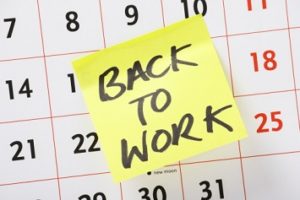A recent study funded by the National Institute for Occupational Safety and Health (NIOSH) found that in addition to fairly well-known negative outcomes, workers who suffer injuries that require days away from work are likely to die sooner than those who had injuries that required only medical treatment. Let’s take a look at this new study and then at some tips for getting your injured workers back to work faster.

Thinglass / iStock / Getty Images Plus / Getty Images
Nut of the Study
The authors of the study linked nonfatal injury cases reported to the one state’s workers’ compensation system for 1994–2000 with Social Security Administration data on individual earnings and mortality through 2014. They concluded that lost-time occupational injuries are associated with a substantially elevated mortality hazard. This points to a formerly unmeasured cost of these injuries and a further reason to focus on preventing them.
According to NIOSH, other studies have shown that the chances of returning to work drop dramatically the longer a worker remains away from work. NIOSH claims that while more serious diagnoses are associated with longer periods off work, minor diagnoses can also lead to disability if the recovery and return-to-work processes are not properly managed.
Return to Work—Who’s Responsible?
The Department of Labor’s Office of Workers’ Compensation Program (OWCP) claims that the onus is on both the worker and the employer to get injured workers back to work as soon as possible. Although the information is aimed at the federal sector, the tips are practical for the private sector as well.
According to the OWCP, employers should have a plan to return injured employees back to suitable employment. Reemployment involves less wage loss. The longer injured workers are out of work, the less likely they are to return.
The Worker’s Responsibility
If a worker is injured it is his or her responsibility to:
- Seek or accept suitable employment;
- Resume regular employment, if capable;
- Provide his or her physician with information on any available light duty;
- Let the employer know of limitations imposed by attending physician; and
- Report efforts to obtain suitable employment.
Employer’s Responsibilities
If a worker is injured, as the employer, you should:
- Authorize medical care;
- If alternative positions are available for a partially disabled worker, advise the worker in writing of specific duties and physical demands; and
- Where no alternative position is available, advise the injured worker of any accommodations you can make.
Making a Job Offer
As part of a plan to get an injured worker back to work, you should be prepared to make a job offer. The job offer should include:
- A description of specific job duties to be performed;
- Specific physical requirements of the position and any special demands or unusual working conditions;
- The work schedule;
- Organizational and geographical location of the job;
- Date on which the job will first be available;
- Date by which a response to the job offer is required; and
- Pay information.
The job should be offered in writing and be based on the medical restrictions.
Tomorrow we will take a look at a study that points to the monetary benefits to employers of return to work programs.
